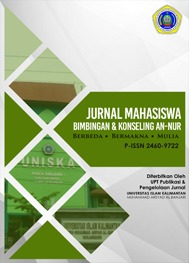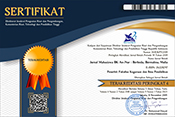LAYANAN BIMBINGAN BELAJAR BAGI SISWA YANG MENGALAMI GANGGUAN BELAJAR PADA SISWA TINGKAT SEKOLAH DASAR
(1) IKIP PGRI Pontianak
(2) IKIP PGRI Pontianak
(*) Corresponding Author
Sari
Elementary school students' learning disorders are a problem that must be addressed immediately. Bearing in mind that the development of elementary school level students is characterized by the ability to make sense of what they read, being able to rewrite it, and spelling. Children will usually begin to read fluently at the age of 6 to 7 years when they are in elementary school, first and second grade. However, the facts fieldwork shows that there is a small portion of students in first and second grade elementary schools who are not yet able to read fluently and some even do not yet know letters. Of course, this is a question for teachers and parents regarding this method of learning, and it turns out that this condition is Disturbances experienced by children when learning. The aim of this research is to help children who choose dyslexic learning groups, apply the Fernald method to children with dyslexia, and change dyslexic children using the Fernald method. The method used in this research is Single Subject Research (SSR), using the A-B-A research design, there is repetition. base line phase or condition, which describes two conditions, namely before the intervention is given and after the intervention. Based on the research results, the Fernald method is suitable for students who experience dyslexia. Judging from the results before the intervention and after the intervention
Kata Kunci
Teks Lengkap:
PDFReferensi
Abbaszadeh, M., & Sardoie, G. (2016). Compare Academic Self-efficacy and Self-regulation Among Students with Learning Disorder and Without Learning Disorder in Normal Elementary Schools ( Fourth and Fifth Grade ) of Kerman. 9 (2), 751–759.
Aflahah, U., Fathurohman, I., & Purbasari, I. (2021). Gangguan Belajar dan Cara Mengatasinya Dalam Film Taare Zameen Par. Jurnal Educatio FKIP UNMA, 7(3), 1143–1153. https://doi.org/10.31949/educatio.v7i3.1356
Aulia, S. (2022). Aulia_Shafira_18003054_5128_2022.pdf.
Cahyani, L., & Wahyuni, E. (2023). Eektivitas pendekatan mindfulness untuk meningkatkan resiliensi akademik siswa sekolah menengah atas: literarure review. Jurnal Mahasiswa BK An-Nur : Berbeda, Bermakna, Mulia, 9, 82–91.
Dan, M., Siswa, B., & Sd, K. (2017). ANALISIS FAKTOR-FAKTOR KESULITAN MEMBACA. 10(1), 28–33.
Elmansyah, T., Maulana, R., & Nini. (2023). DESKRIPSI GANGGUAN DISLEKSIA PADA SISWA SEKOLAH DASAR KECAMATAN SEGEDONG. Jurnal Mahasiswa BK An-Nur : Berbeda, Bermakna, Mulia, 9, 260–267.
Filippello, P., Buzzai, C., Messina, G., Mafodda, A. V., & Sorrenti, L. (2020). School Refusal in Students with Low Academic Performances and Specific Learning Disorder. The Role of Self-Esteem and Perceived Parental Psychological Control. International Journal of Disability, Development and Education, 67(6), 592–607. https://doi.org/10.1080/1034912X.2019.1626006
Hasanah, L., Nafisyah, I., Pratiwi, J. A., & Putri, N. A. (2022). Problematika pembelajaran daring anak mengalami kesulitan belajar “disleksia.” Jurnal Golden Age, Universitas Hamzanwadi, 6(01), 291. https://doi.org/10.29408/goldenage.v6i01.5639
Irradhiatul Jannah dan Irdamurni. (2021). Meningkatkan Kemampuan Membaca Kata Menggunakan Metode Fernald bagi Anak Disleksia. Journal of Basic Education Studies, 4(1), 509.
Islam, U., Muhammad, K., Al-Banjari Banjarmasin, A., Artati, K. B., Herdi, H., & Artikel, I. (2023). Aplikasi Cyber Counseling-Ngobrol Yuk Berbasis Android Whatsapp) Untuk Meningkatkan Psychological Well-Being Siswa Sekolah Dasar. 9, 53–63. https://ojs.uniska-bjm.ac.id/index.php/AN-NUR
Jatmiko, A. (2016). Memahami dan Mendidik Anak Disleksia. Proceedings of The 1st Annual Internasional Conference on Islamic Early Childhood Education, 1(December), 159–166. http://ejournal.uin-suka.ac.id/tarbiyah/conference/index.php/iciece/iciece1
Kusmayanti, S. (2019). Membaca Permulaan Dengan Metode Multisensori. Jurnal Pendidikan Universitas Garut, 13(01), 222–227.
Morsanyi, K., van Bers, B. M. C. W., McCormack, T., & McGourty, J. (2018). The prevalence of specific learning disorder in mathematics and comorbidity with other developmental disorders in primary school-age children. British Journal of Psychology, 109(4), 917–940. https://doi.org/10.1111/bjop.12322
Nik Haryanti, Muhibbudin, M., & Imam Junaris. (2022). Analisis Kesulitan Belajar Siswa (Disleksia dan Disgrafia) di Masa Pandemi Covid-19. Journal of Instructional and Development Researches, 2(1), 7–16. https://doi.org/10.53621/jider.v2i1.60
Nopianti, L., Kristi, A., & Sari, P. (2023). KEMAMPUAN MEMBACA PADA SISWA KELAS I SD NEGERI TEMBONG KECAMATAN GARAWANGI. 2(7), 1949–1956.
Ogunsola, ’Bukunmi A. (2018). Teacher’s Qualification and Dyslexia Identification in Primary Schools in Oyo State, Nigeria. Africa Education Review, 15(4), 36–66. https://doi.org/10.1080/18146627.2017.1302308
Pemahaman, P., Energi, K., Dan, P., Melalui, B., Pembelajaran, M., Make, T., Pada, A. M., Kelas, S., & Wardani, R. D. W. I. (2012). Fakultas keguruan dan ilmu pendidikan universitas sebelas maret surakarta. 1–18.
Prasetya, Z. (2017). Metode Fernald untuk meningkatkan kemampuan membaca pada anak disleksia. Jurnal Psikologi Universitas Muhammadiyah Malang, 1–84. http://eprints.umm.ac.id/43371/1/jiptummpp-gdl-zunustripr-47298-1-zunus20-6.pdf
Rahmatillah, R. A. (2020). Penerapan Metode Fernald Terhadap Keterampilan Membaca Pada Peserta Didik Berkesulitan Membaca Kelas II SDN Purwantoro 2 Malang. Tesis, 1–8.
Rikawati, K., & Sitinjak, D. (2020). Peningkatan Keaktifan Belajar Siswa dengan Penggunaan Metode Ceramah Interaktif. Journal of Educational Chemistry (JEC), 2(2), 40. https://doi.org/10.21580/jec.2020.2.2.6059
Rohmah, S., Wahyuningtyas, D. P., Saputra, N., Nugroho, A., & Hutauruk, T. L. (2022). Analysis Of The Factors That Cause To Learning Difficulties Among Elementary School Students In The Digital Era. Cendikia: Media Jurnal Ilmiah Pendidikan, 13(2), 253–259.
Rosmawati, D., & Juni Samodra, Y. T. (2021). c. JPPTK: Jurnal Pendidikan Pembelajaran & Penelitian Tindakan, 1(1), 92–99. https://doi.org/10.53813/jpptk.v1i1.11
Sukmawati, R., & Tarmizi, M. I. (2022). ANALISIS KESULITAN MEMBACA PERMULAAN PADA PESERTA DIDIK DISLEKSIA KELAS RENDAH SEKOLAH DASAR. Pendas: Jurnal Ilmiah Pendidikan Dasar, 27(2), 58–66. http://117.74.115.107/index.php/jemasi/article/view/537
Ukhti, A., Utami, I. S., Zulmiyetri, & Budi, S. (2022). Meningkatkan Kemampuan Mengenal Huruf Vokal Melalui. Edumaspul: Jurnal Pendidikan, 6(1), 750–754.
Washburn, E. K., Joshi, R. M., & Cantrell, E. B. (2011). Are preservice teachers prepared to teach struggling readers? Annals of Dyslexia, 61(1), 21–43. https://doi.org/10.1007/s11881-010-0040-y
Washburn, E. K., Mulcahy, C. A., Musante, G., & Joshi, R. M. (2017). Novice Teachers’ Knowledge of Reading-related Disabilities and Dyslexia. Learning Disabilities: A Contemporary Journal, 15(2), 169–191.
Sunarto, K. (2004). Pengantar Sosiologi. Jakarta: Lembaga Penerbit Fakultas Ekonomi Universitas Indonesia.
DOI: http://dx.doi.org/10.31602/jmbkan.v10i1.14024
Refbacks
- Saat ini tidak ada refbacks.
Akun Akademik Anda Terhubung dengan :
Didedikasikan Untuk:
Jurnal Mahasiswa BK An-Nur : Berbeda, Bermakna, Mulia disseminated below Lisensi Creative Commons Atribusi 4.0 Internasional.

















